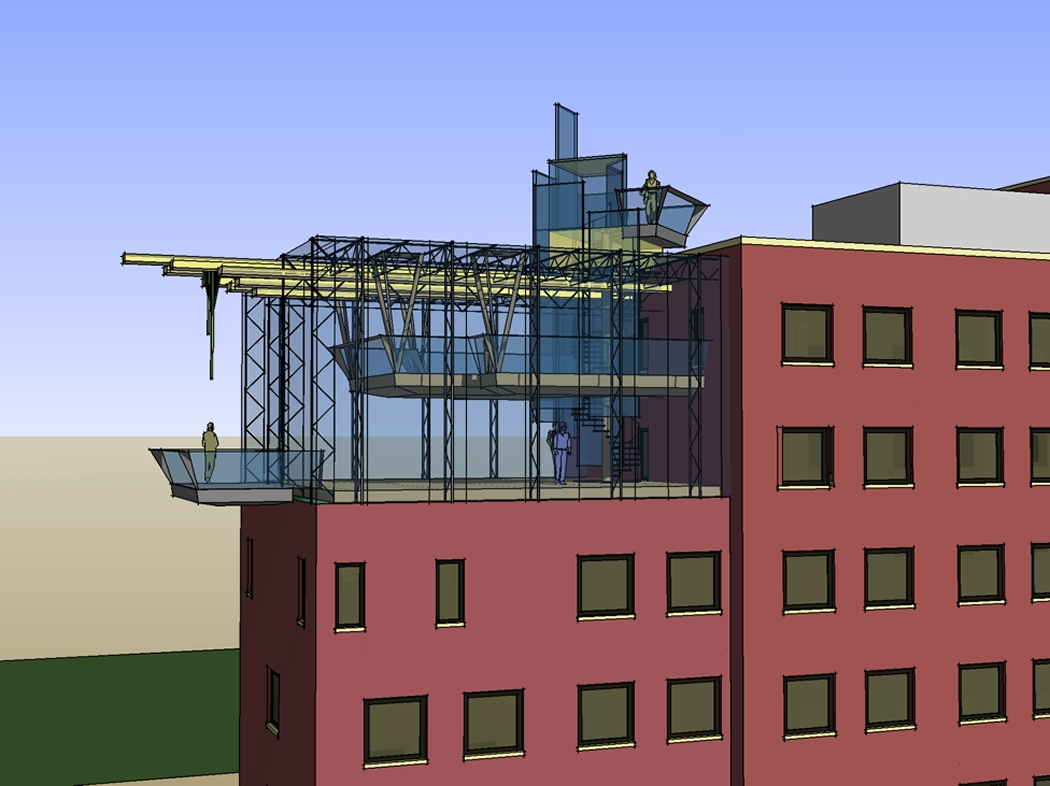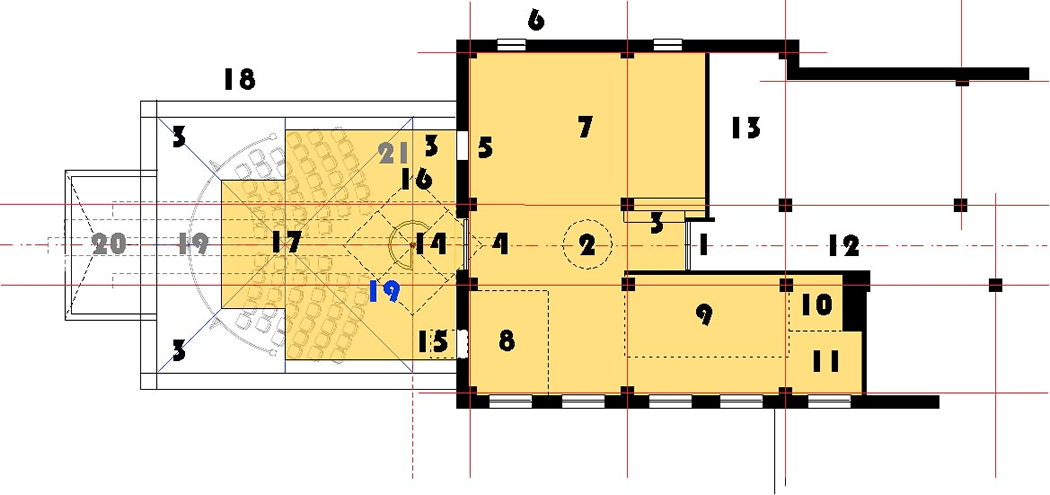NavCenter Five Facility
July 1 Preliminary Model - Concept Description | | Description | Structure and Systems | | This is a space rich in prospect. Its location and orientation provides a distinct and unique view of reality. The design exploits this opportunity - the space is a stage from which to view the landscape and conceive new ideas, methods and futures. What else is learning and design? The building’s theme is an exact metaphor of its own purpose. True prospect is rare in architecture. This is a bold structure but not an overstated one. | | The entry into the NavCenter is from the Hallway on the 9th floor through double glass doors Just North of the fire escape stairway. This area is the existing end of the 9th floor [to the 5th window in the sketch below] and will be used for education staff mini- workPODS, reception, rest rooms, storage, production area, and event food service. | | This 9th floor area is largely an open space with MG Taylor/AIArmature and WorkFurniture At the North end of this existing space, where the center window was paced, a pair of matching glass doors open onto a suspended balcony area. The existing windows on the 9th floor open into the new two story glass enclosed space that is accessible by the semi glass-enclosed stairway which also ascends to the “Crows Nest” above the 9th floor roof deck. Upon entering the space, several vertical and horizontal elements are converging: circular stairway, horizontal and vertical translucent air plenums; they “block” the view in all directions and create a small alcove from which to approach the greater space. Few people have been in a two story glass space as open as this and over a 100 feet in the air. The alcove provides an opportunity to survey the options while feeling protected. From this “alcove,” the choices of direction are possible each with a different Character. How WorkWalls and WorkFurniture are placed, at any given time, sets the degree of prospect or refuge in the space which means they can be modulated to match the requirements of the work-process at hand. | 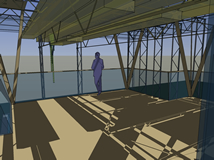 | | Stepping around the stairway and vertical plenum leads out onto the Balcony which is hung from the transparent truss and glass roof. This platform covers about 60% of the floor below. The Balcony will be used for event breakout areas and project work areas. | | | From the 9th floor Entry one can go up to the Crows Nest, out onto the interior 9th floor level Balcony or down onto the 8th floor level which is the main large group process area - called the Radiant Room [link]. This use of vertical space creates four zones each having a different character and set of functions. The mix of prospect and refuge is appropriate for the uses of each area. This is a high variety environment, simply done. | | | The structure is local shop-modified open web steel trusses that span the roof and three walls of the addition. A similar truss system is used for the floor which sits on and is tied to the existing 8th floor roof slab. This truss system allows for air circulation around and under the entire space with the exception of the existing north-facing brick wall. Two wide-flange beams, the height of the floor truss system, are attached to the existing slab at the width of the exterior 8th floor-level Balcony; they cantilever to support the new balcony. Horizontal sheer is taken by the attachment of the floor trusses to the existing slab and by the stiffening of the joints between the roof, wall and floor trusses. The 9th floor internal balcony is suspended from the roof truss system and attached to the existing structure at its north wall. The steel structure is made of from standard light weight open web steel joists that are, once erected, are connected to create a space frame. | | A steel, fiberglass and glass horizontal and vertical plenum feeds the surrounding air circulation system and also brings in fresh air [see picture at left]; this will be discussed in more detail below. Some structural elements are incorporated into this assembly. | | The idea of the energy system is not to oppose and overwhelm nature - it is not to resist - but to create a building that is responsive to it. The human body does not deal with heat and energy transfers by creating an absolute barrier to them; it responds to various conditions with a variety of strategies that are within the response range of the organism. In the same way, this building will have a variety of actions it can take in response to the specific conditions it faces. | | The ability to circulate air from one side of the building to the other through the envelope that surrounds the entire space; the opening and shutting screens that can be controlled by the building users or run on automatic; the use of double layered glass and vents that open and close as required - these are some of the means by which temperature extremes are attenuated. The air that is used in the interior space can be be kept separate from the the air circulating through the walls, roof and floor. This system works like a double shell structure with the contained air creating a 60 to 85 degree buffer zone between the exterior condition and the interior. The interior glass wall is isolated from the the steel joists with an insulating material to impede conduction. | | The HVAC system, along with the active and passive solar attributes of the building, attenuates weather extremes but not an intimate awareness of time-of-day and the seasons. The users of this space are engaged with nature. Control of light and temperature is easy but actions have to be taken to do it. No sheet rock; no carpet; no noisy air conditioning and polluted air; no isolation from a world that lives. | | | | [1] Double glass door Entry from the existing hallway into the NavCenter space. [2] KWIB Station - this is the “reception” navigation center for the entire operation. [3] Book cases, Library elements. The library is distributed throughout the space. [4] Double glass doors to the two story portion of the Center. These will be open most of the time but can be closed for sound control reasons. [5] Remove existing windows and replace with folding shutter for sight and sound control; default mode is open. [6] Existing exterior windows on East and West sides to remain as is. [7] Workstation (miniPods) for 8 staff members of the Education Group. [8] Food Preparation Area. [9] Men and Women’s Rest Rooms. [10] Storage. [11] Production area (copy machines, FAX, etc.). [12] Existing Hallway. [13] Existing Fire-Escape Stairway. [14] Circular Stairway up to observation/Reading “crows-nest” and down to the (8th floor) Radiant Room, group process area. [15] “Dumb-Waiter” to 8th floor level. [16] Documenting & Video Editing Stations. [17] Break-out and Project Team areas. [18] Exterior “double shell” glass and steel truss wall and roof system. [19 - blue] Roof level “Crows Nest.” [19 - gray] Clear story space over radiant Room. [20] 8th floor level cantilevered Balcony looking North (at Zoo). [21] Folding Wall & Storage Area on 8th floor level. | | | This is a compact space yet it has full NavCenter functionality. It will operate much like the MG Taylor Boulder, Acacia and Hilton Head facilities did [link]. These were ship-like [link] and small - yet capable of high levels of productivity; we invented much of our methodology in these three Centers and served clients of all kinds. The method is the same as in large Centers, however, the work is performed differently in compact NavCenters. Many KnowledgeWorkers prefer them. As a satellite in a system of NavCenters, this foot-print represents an appropriate [link] scale. | 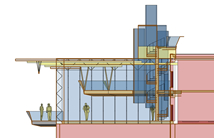 | | In addition to its transparent top and sides, this environment provides three levels from which to see the world and to think and interact with it. These distinct points-of-view have specific cognitive implications that are related to the work being done. | | | Functionality is not to be confused with capacity. The first pertains to the ability to perform all the kinds of work necessary for meeting the NavCenter mission [link]; the second, to the amount of work that can be performed at any given time. It is important that the variety of the kinds of spaces and architectural viewpoints be great - this is true no matter the size of the NavCenter. Another thing to consider with size are the factors of walls and enclosure. There are different kinds of space: utility, logistical and effect. Utility space pertains to what is needed to do things. Logistical space, to the pathways that get you to the places where you do things. Effect space, to those elements that make space and define it. The outer walls and roof of this NavCenter are glass. All things being equal, if these were solid walls, at least 30% more area would be required to create the appropriate visual framework appropriate for this functionality [link]. While the structure and glass elements do create a screen, the outer landscape and sky set the boundaries of this environment. In this regard, this is an extremely efficient building when you consider what is not there. | | The materials palette is simple: steel with a backed enable finish; glass, colored fiberglass, cork flooring; the exiting brick and stone caps; the standard AI WorkFurniture finishes; interior landscaping. There will be landscaping on the 9th floor roof South of the Crows Nest to shield from view the roof-mounted HVAC units and screen the glass from sunlight. The tall aspect of the “Crows Nest” Further shields the roof glass and, with the horizontal plenum, provides spatial definition for the interior. The transparent and translucent panels, along with the steel structure and moving blind system, create layers of screening and wall/roof thickness. Light, filtered, unfiltered, in shade and shadow, reflecting and picking up the color of steel, woods and plants, becomes the main force of the architecture. The nine story elevation, coupled with the slope of the site as it travels Northward, creates an accentuated view of the landscape. On the 8th floor level, the curved WorkWall® and the suspended balcony above become the dominate elements for the creation of interior space. WorkWalls on the 9th floor level work areas serve the same function. This serves to focus attention on the work-at-hand while being in a surround of unlimited vistas. | | | The building as described and shown here is the shell - the environment valve. It mediates outside extremes without eliminating the outside. What people use and touch, however, is the WorkFurniture - it is these components that turn a glass platform into a home. This is the next layer inward; it establishes the context for human scale. The shell is composed of steel and glass; theArmature [link] andfurniture predominately of wood. The shell is transparent and translucent, immovable;the Armature and furniture is solid, mobile and adaptable. WorkFurniture, technologyand work-processes are what make the space into an information rich,knowledgefactory[link]. | | There is a third layer and that is tooling: computers, work surfaces, media, physical storage and display, and so on. These scales descend in order: environment scale, building scale, human scale, below human scale; these are layers. Layers of utility and layers of meaning. Meaning comes from the application of connotation and denotation. | | 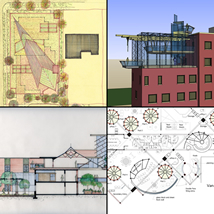 | 4 Projects explores both the value of creating a new urban workplace and the means necessary to accomplishing it. Link
to go to individual projects, click on pictures | | | Return: to NavCenters A Network In Development - Facility #5 | posted: July 2, 2003 • revised:July 26, 2003 | |
